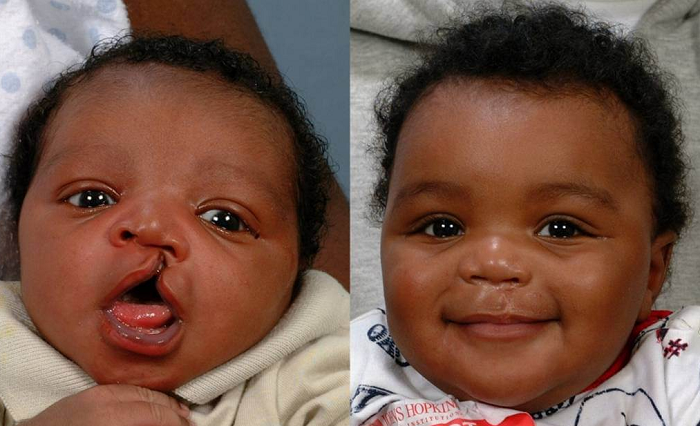
Cleft lip or palate: Are there interventions?
Globally, one of the most common congenital anomalies is a cleft lip and/or palate. According to the Word Health Organisation (WHO), it occurs in every one in 500 to 700 births.
There is not much information about the incidence of a cleft lip and/or palate in Ghana.
Advertisement
Cleft lip and/or palate refers to a group of conditions where the lip and the roof of the mouth of an unborn baby don’t join up properly the way they are expected to.
A baby can have a cleft lip or a cleft palate or both.
Children born with a cleft lip have a gap in their lip and those born with cleft palate have a hole in the roof of their mouth. A baby can have a cleft lip or a cleft palate or both.
Causes
There is no known cause of cleft lip and/or palate. However, there are certain risk factors associated with a cleft.
These include smoking during pregnancy, certain medications taken during pregnancy (for epilepsy, diabetes) or genetic factors (if there’s someone in the family with a cleft). Cleft can be syndromic or non-syndromic.
A syndromic cleft refers to clefts associated with a syndrome such as Pierre Robin syndrome. Non-syndromic clefts refer to clefts that are not associated with any syndrome.
Impact
Generally, the impact of a cleft on a child varies, depending on the type of cleft. A cleft impacts on a child’s feeding and communication development (language and speech), among other things.
Babies with a cleft lip/cleft lips generally do not have difficulties with feeding as compared to babies born with a cleft palate.
Babies with a cleft palate often find it difficult to breastfeed. They often need special equipment to be able to feed (or) to thrive (squeezy bottles etc.).
This can be very tiring for the nursing mother. Some babies with a cleft may also have some sensory difficulties.
Surgical intervention
Surgical intervention for babies born with a cleft lip and/or palate depends on a lot of factors. Generally, however, a cleft lip repair happens between three and six months old.
A cleft palate repair on the other hand happens between eight and 12 months of age.
Ideally, surgeons and other professionals involved in the care of children born with cleft aim at getting the cleft repaired before the baby’s first birthday.
This is, however, often not the case in low and middle-income countries as surgeries are done later than the ideal surgical time often due to financial constraints on the part of the caregivers. The multidisciplinary team (MDT) involved in the care and management of babies born with cleft include orthodontists, paediatric surgeons, plastic surgeons, dentists, speech and language therapists, otolaryngologists, audiologists, clinical psychologists and nurses.
Ghana currently has two comprehensive cleft panel clinics at the Korle Bu Teaching Hospital (KBTH) in Accra and Komfo Anokye Teaching Hospital (KATH) in Kumasi.
Feeding, communication intervention
Due to difficulties with feeding and communication associated with cleft, speech and language therapy is required to provide the appropriate intervention for children born with this condition. The role of the speech and language therapist in the management of clefts includes screening, making diagnosis and treating speech, language and feeding difficulties associated with it.
International Non-Governmental Organisations (NGOs) such as Operation Smile, Transforming Faces and Smile Train have played major roles in supporting cleft care in Ghana.
Hopefully, the National Health Insurance Scheme will one day cover the care and management of children born with cleft in Ghana in order to receive timely interventions.
The writer is a Speech & Language Therapist/Clinical Tutor, University of Ghana.



